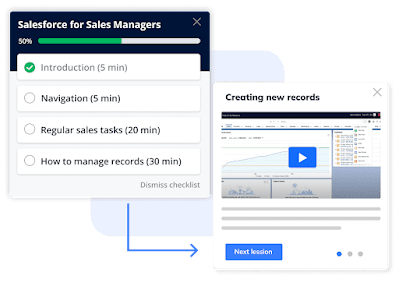Are Old Onboarding Practices Failing to Engage Your New Hires? It's Time for Digital Employee Onboarding
Good employee onboarding is an essential aspect of retention and productivity. Helping new hires get oriented with the tools they need for the job means they can quickly become comfortable and productive at your business. Digital adoption tools like Usetiful can help you achieve these aims and improve your employee retention figures.
Speak to recruiters and talent acquisition teams, and they'll tell you the same thing: hiring is very challenging right now. This situation is especially true in the tech sector.
While the data might not support the narrative around the Great Resignation, employers are still struggling to find great staff. In theory, remote and hybrid work means businesses have access to a greater talent pool. But in practice, it's made hiring more competitive as potential employees field offers from wide locations.
Additionally, the world is going through a massive cost of living crisis. Global inflation is at around 7.5%. Rates in the eurozone are about 9%, with US figures around 8%. As a result, employees are expecting higher salaries. But as a recent survey by the payment platform Branch suggested, low wages were one of the most significant factors contributing to hiring problems.
Paying higher salaries is something that companies can at least control. However, in the tech industry, huge salaries aren't even enough to bridge the skills gap and compete with rivals for top talent.
When hiring is challenging, two things become incredibly important for employers.
#1. You need to ensure that you retain your best employees
#2. You need to get your onboarding process right so that any new employees can fit in.
How onboarding affects retention and productivity
We've all known for a long time that onboarding impacts retention. Research suggests that a good onboarding program can increase new hire retention by over 80%. Additionally, the same study indicates that a positive onboarding can boost productivity by a staggering 70%.
Staff turnover is a significant issue for modern companies. Some estimates suggest that replacing an existing staff member can cost more than their annual salary when you account for recruitment fees and productivity loss.
There are three main areas of onboarding that recruitment teams need to consider. They are:
Organizational onboarding: Employee onboarding that teaches new hires about things like on-site parking, health benefits, company policies, etc.
Social onboarding: Helping new hires build connections and relationships inside the office.
Technical onboarding: Helping new hires learn about the software tools they will use for their job.
The main focus of this piece will be on technical onboarding. However, some of what we talk about can relate to organizational onboarding, such as learning to unlock the value of healthcare or benefits platforms that are part of your overall compensation package.
Remote working
Remote working has added an extra wrinkle of complexity to employee onboarding. Many new hires struggle to adapt and connect with teammates without working physically in the same space.
However, getting this process right is essential. Statistics suggest that almost one-third of new hires leave within the first six months. The most commonly cited reason? Ineffective onboarding.
There are several ways that organizations can counter these issues. One of the most effective ways is by implementing a remote employee onboarding checklist.
A remote onboarding checklist can include lots of different things depending on your organization. Some of the most important are:
Send pre-boarding resources
Book a call with IT
Introduce new hires to teammates virtually
Run role-specific training
Training for tools and software stack
What is ineffective onboarding?
There are a few ways we can look at this. We're primarily going to focus on the technical side rather than the HR stuff.
Some of the hallmarks of Ineffective onboarding are:
Outdated onboarding practices that just don't engage your new hires
Onboarding practices that fail to account for the new reality of hybrid or remote work
Actively bad onboarding that works against your goals of making new hires feel welcome and in control
How digital employee onboarding engages new hires
When employee retention is your objective, engagement is essential. Digital onboarding platforms, like Usetiful, provide a controllable experience layer that helps users learn how to use applications. One of the best things about our tool is that it is no-code, so you don’t need software development skills to create these overlays on the applications your new hires will use.
In the world of software development, users must hit the ground running and understand the value of an application as quickly as possible. When they achieve this, it makes them more likely to keep using the product. Additionally, it helps them get the maximum value from the product and its attendant features.
The same principles that apply to customer acquisition in consumer products also apply to employee onboarding. At their core, both concepts have similar goals: engage and retain users through positive experiences.
So, let's explore how you can apply these principles to enhance your employee onboarding experience.
#1. Make onboarding interactive
Making your onboarding process interactive is the best way to grab and hold your employee's attention. Interactivity makes things more fun, engaging, and memorable.
Employee onboarding requires a lot of paperwork. Additionally, you need to ensure employees read health and safety documents, company policies, or anything else that is covered in your employee handbook.
We recommend using digital onboarding to enhance your employee portal or existing onboarding software. For starters, you can use tooltips to help employees find their way around the application. More importantly, you can build checklists that ensure your employees always know what they need to do and where they are in the process.
Additionally, you can use our onboarding software to help ensure employees sign up for various healthcare benefits. Read our case study on how we helped RoHealth expand its customer activations by building product tours that explain its offer.
#2. Help users get proficient with your software stack
Each company has its own software stack and workflow. New hires need to figure out how to use these tools. Manuals or training days don't cut it anymore. Users need something that is more responsive and embraces learning by doing.
Usetiful can help you create product walkthroughs for any of the third-party software your company uses. Our digital adoption tool uses a combination of tooltips, product tours, and walkthroughs to show users how apps work and how they can unlock the potential of features and functions.
Automating this element of onboarding saves a lot of time. What's more, most employees want self-service options when they are figuring out how to use a particular tool.
#3. Personalization
One of the biggest benefits of using a digital adoption platform is personalization. When you want to help someone settle in at work, you can make their onboarding work for them.
There are many different ways to achieve a degree of personalization in your onboarding. At the simplest level, you can do things like incorporate user data into your communication and instruction videos. Even just addressing someone by their name can boost engagement.
Where it gets a bit more interesting is using segments. Let’s say you have data on your new hires, like their role, experience, familiarity with software, etc. You can use this to flavor their onboarding experience. For example, you can leverage this information to guide the types of walkthroughs, tooltips, or product tours they use and make them more relevant to each user.
Additionally, you can also use data on how they've engaged a piece of third-party software. If your new hire hasn't used certain features that are helpful to productivity, you can give them a nudge or offer them a quick tutorial.
Finally, not all businesses use a piece of software in the same way. Let's say you have a workflow that uses an app but only for some of its features. You can design an onboarding that shows how your company does things in the app. Additionally, this will double up as a way to show how your business does things. For example, you can use it to communicate your brand guidelines, formatting, or other service expectations.
#4. Improve through feedback
Digital employee onboarding tools, like Usetiful, collect user data. Of course, it's all done in a GDPR-compliant way. It helps with employee retention because you can see how users are engaging with your company portal and the third-party software you use.
In this scenario, you can collect a lot of information to power your onboarding. You can see where people lose interest, which tasks they like, and how they engage with applications. You can use all of this data to improve things on your end. The employee retention gains can be endless.
Also, imagine a situation where you are experiencing a high staff turnover. You can start to record information about your onboarding and link it to hires who end up leaving. With enough info, patterns will emerge. You might even be able to predict who is in danger of leaving based on their actions in the first few weeks. From there, you can intervene.
Summary
Getting your onboarding process right is crucial if you want to retain employees in this challenging hiring market. Strong employee retention is only possible when you properly engage new hires and help them feel comfortable. Digital employee onboarding, using tools like Usetiful, can help create positive user experiences that help new hires feel at home. By overlaying tooltips, product tours, and onboarding checklists over your employee portal or the third-party software you use, new staff members can accelerate their productivity. And because you are automating the process, it saves your HR team hours of time.




